






Fire in the U.S. 2015 – 2019:
● U.S. fire departments responded to an average of 346,800 home structure fires per year








● U.S. fire departments responded to an average of 346,800 home structure fires per year
Home may be the place people feel safest, but it’s actually the place they’re at greatest risk of injury or death from fire.
Do you know what to do if a fire starts in your home? You have less than three minutes to safely escape a typical home fire from the time the smoke alarm sounds. The best way to avoid injury in case of fire is to be prepared. By taking steps to eliminate potential fire hazards in your home and knowing what to do in case a fire does break out, you can help yourself and your family avoid property damage, injury and even death.
Sources: National Fire Protection Association, National Safety Council
Fire is the sixth-leading cause of unintentional injuryrelated death in the U.S.
(National Safety Council)
A U.S. fire department responds to a fire every 24 seconds.
(National Fire Protection Association)
A home fire injury occurs in the U.S. every 43 minutes.
(National Fire Protection Association)

● These fires caused an annual average of:
● 2,620 civilian deaths
● 11,070 civilian fire injuries
● $7.3 billion in direct property damage
● Cooking was the leading cause of home fires and home fire injuries
● Smoking was the leading cause of home fire deaths
Source: National Fire Protection Association
In 2020, there were:
57,481 fires
In 2020, there were:
521 fires
3 civilian fatalities
15 civilian injuries
6 firefighters injured on duty
171 civilian fatalities
479 civilian injuries
4 firefighter deaths on duty
5,280 firefighters injured on duty
In 2020, there were:
414 fires
1 civilian fatality
civilian injuries
firefighters injured on duty
$450 million in property losses
Source: Division of State Fire Marshal, Florida Fires 2020 Annual Report

You have less than three minutes to safely escape a typical home fire from the time the smoke alarm sounds. It is important to have an escape plan before a fire occurs, so everyone is prepared and ready to act.
● Walk through your home and identify all possible exits and escape routes. Note two ways out of each room.
● Make sure that all escape routes are clear of furniture and obstructions.
● Make sure that all doors and windows can be opened easily by all household members.
● If your home has two or more floors, every household member (including children) must be able to escape from the upper-floor rooms. Escape ladders can be placed in or near windows to provide an additional escape route.
● If there are infants, young children or family members with mobility limitations in your home, make sure that someone is assigned to assist them in the event of an emergency.
● Choose an easy-to-find outside meeting place a safe distance in front of your home where everyone can meet after they've escaped.
● Talk about your escape plan with everyone in your home.
● Practice your home fire escape plan twice a year. Practice using different routes to get out. Practice during the day and at night.
A structure fire occurred every 33 minutes and 1 second in Florida in 2020.
70 percent of civilian firerelated deaths in Florida in 2020 occurred in residential properties.
94 percent of civilian firerelated injuries in Florida in 2020 occurred in residential properties.
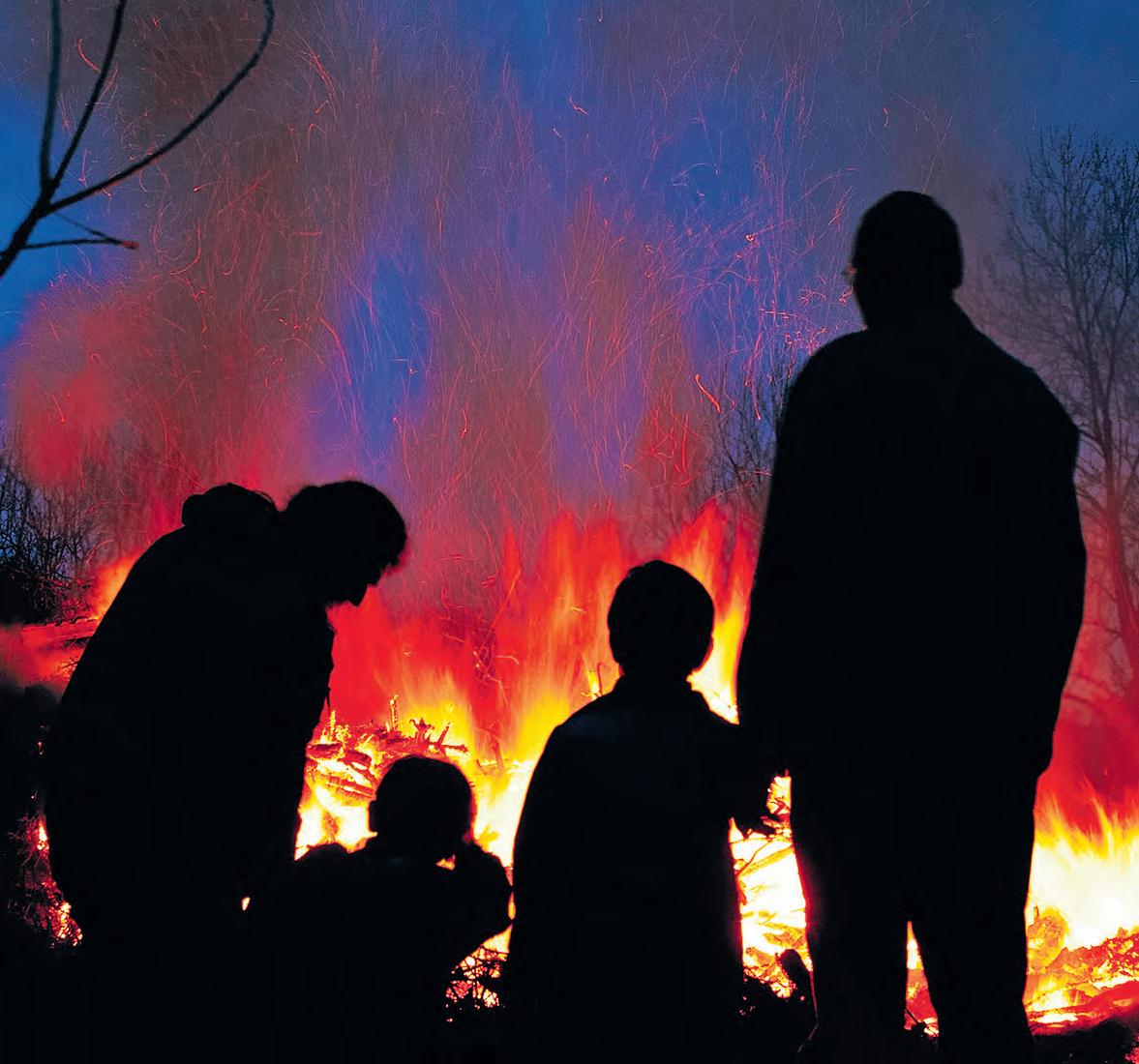
(Division of State Fire Marshal)
Source: National Fire Protection Association
Going beyond the text: When it comes to fire safety, having a home fire escape plan is essential.
Look through the Sunday Tampa Bay Times Homes section for a picture or a floor plan of a home. Use the Home Fire Escape Plan worksheet at nieonline.com/tbtimes/downloads/HomeFireEscapePlanWorksheet.pdf to draw a hypothetical escape plan for the home. Next, imagine that you are a resident of this home. Write a fully developed paragraph explaining how you would escape from a room of your choice. Next, use the Home Fire Escape Plan worksheet to create an escape plan for your own residence. If your home has more than one story, draw an escape plan for each floor. Share the plan with every member of your family.
Florida Standards – Health: HE.612.B.3.3; HE.612.B.4.3; HE.612.B.5.1; HE.612.B.5.3; HE.612.B.5.5; HE.612.C.1.3; HE.612.P.7.1; HE.612.P.7.2 Language Arts: ELA.612.C.1.2; ELA.612.C.1.4; ELA.612.C.1.5; ELA.612.C.3.1; ELA.612.C.4.1; ELA.612.R.2.1; ELA.612.R.3.2; ELA.612.V.1.1; ELA.612.V.1.3 Science: SC.612.N.1.1; SC.612.N.1.5 Special Skills: SP.612.VI.9.11; SP.612.DH.6.3; SP.612.US.8.9
Cooking is the leading cause of home fires and home fire injuries and the second leading cause of home fire deaths.

● DO stay in the kitchen while you are frying, boiling, grilling or broiling food. If you leave the kitchen, turn the burner off.
● DO watch what you are cooking. If you see smoke or the oil smells or starts to boil, turn the burner off.
● DO remain in the home if you are simmering, baking or roasting food. Check it regularly and use a timer to remind you that you are cooking.
● DO keep anything that can catch fire – such as oven mitts, wooden utensils, food packaging or dish towels –away from your stovetop.
● DO turn pot handles toward the back of the stove so that no one can bump them or pull them over.
● DON’T use the stove or stovetop if you are sleepy or have used alcohol or drugs.
Sources: National Fire Protection Association, U.S. Fire Administration
● Always stay in the kitchen when frying on the stovetop.
● Always cook with a lid beside your pan.
● Heat the oil slowly to the temperature you need.
● If you see smoke or the oil smells or starts to boil, immediately turn off the burner.

● Add food gently to the pot or pan so the oil does not splatter.
If you have a grease fire, slide the lid over the pan and turn off the burner. Do not remove the cover because the fire could start again. Let the pan cool for a long time. Never throw water on a grease fire.
If the fire does not go out or you don’t feel comfortable sliding a lid over the pan, get everyone out of your home. Call the fire department from outside.
Source: National Fire Protection Association
From 2017 to 2019, U.S. fire departments responded to an average of 187,500 residential cooking fires each year.


These fires caused an estimated:
Source: U.S. Fire Administration
● For a stovetop fire, smother the flames by sliding a lid over the pan and turning off the burner. Leave the pan covered until it is completely cooled.
● For an oven fire, turn off the heat and keep the door closed.
● For a microwave fire, leave the door closed, turn the microwave off and unplug it from the wall.
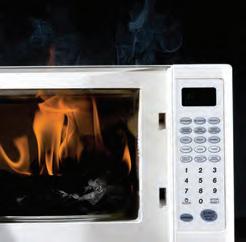
● Never throw water or use a fire extinguisher on a cooking fire.
● Get everyone out of the home.
● Close the door behind you to help contain the fire.
● Call 9-1-1 from outside the home.
Source: National Fire Protection Association
If the fire does not go out or you have any doubt about fighting it:
In 2014 – 2018, U.S. fire departments responded to an annual average of 8,900 home fires involving grills, hibachis or barbecues each year. Grill fires cause an estimated $37 million in property loss annually. Seventy-nine percent of all home grill fires involve gas grills.
● If you use a starter fluid, use only charcoal starter fluid. Keep charcoal fluid out of the reach of children and away from heat sources.
● Never add charcoal fluid or any other flammable liquids to the fire.
● When you are finished grilling, let the coals cool completely before disposing of them in a metal container.
● Grills, smokers and fire pits should only be used outdoors.
● Place grills away from your home and deck railings and out from under eaves and overhanging branches.
● Never leave a grill unattended.
● Clean grills often and remove grease or fat build-up.
● Keep children and pets at least three feet away.
● Always make sure your gas grill lid is open before lighting the grill.
● If the flame goes out, turn the grill and gas off and wait at least 5 minutes before re-lighting it.
● If you smell gas while cooking, immediately get away from the grill and call the fire department. Do not move the grill.
● Always check your propane gas tank hose for leaks before using your grill for the first time each year.
● To check for leaks, apply a soap-and-water solution to the hose. A propane leak will release bubbles.

● If your grill has a gas leak, by smell or the soapy bubble test, and there is no flame, turn off both the gas tank and the grill.

● If the leak stops, get the grill serviced by a professional before using it again.
● If the leak does not stop, call the fire department.
Sources: National Fire Protection Association, U.S. Fire Administration
Every Wednesday, the Taste section of tbt* Weekend includes several recipes for readers to try. Look through the Taste section of a recent tbt* Weekend print or digital edition and find a recipe that appeals to you. Read the recipe carefully, and write down the answers to the following questions:

● What method(s) of cooking are called for?
● What kitchen appliance(s) will be used?
● What equipment and utensils will be needed? Don’t forget safety equipment that may not be listed in the recipe, such as oven mitts or a lid.
Next, use the information on these two pages to write a paragraph summarizing the information above and outlining the precautions that are needed to safely prepare this recipe. Share your recipe and paragraph with your class or family.
Florida Standards – Health: HE.612.B.5.2; HE.612.B.5.3; HE.612.B.5.5; HE.612.C.2.8; HE.612.P.7.1; HE.612.P.7.2 Language Arts: ELA.612.C.1.2; ELA.612.C.1.4; ELA.612.C.1.5; ELA.612.C.3.1; ELA.612.C.4.1; ELA.612.R.2.1; ELA.612.R.3.2; ELA.612.V.1.1; ELA.612.V.1.3 Special Skills: SP.612.VI.9.11; SP.612.US.8.8 Science: SC.612.N.1.1


● Always have electrical work done by a qualified electrician.
● When buying or remodeling a home, have it inspected by a qualified home inspector.
● Only use one heat-producing appliance (such as a coffee maker, toaster or space heater) plugged into a wall outlet at a time.
● Major appliances (such as refrigerators, dryers, washers, stoves, air conditioners or microwave ovens) should be plugged directly into a wall outlet. Extension cords and power strips should not be used.
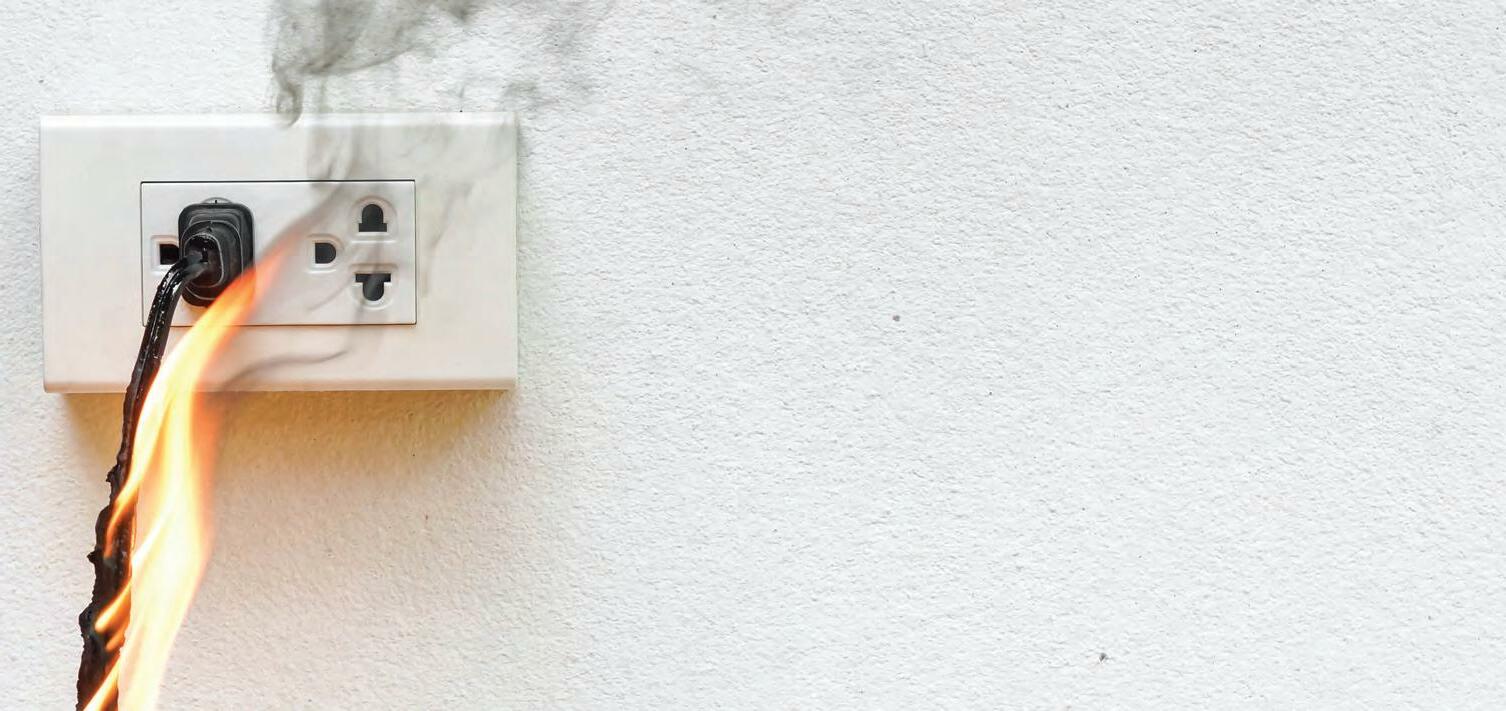
● Be sure that the light bulbs in your lighting match what is safe for the lamp. There should be a sticker that indicates the maximum safe wattage.
● Light bulbs in living areas, including closets, should have a shade or globe for protection. Light bulbs can get very hot and cause a fire if something that can burn is too close.
Sources: Electrical Safety Foundation International, National Fire Protection Association
Electrical failure or malfunction is a leading cause of home fires year after year. Many home electrical fires can be prevented by understanding basic electrical safety principles and following safe practices.
From 2014-2018, electrical equipment (such as wiring, lighting, cords and plugs) was involved in an annual average of:
● 34,000 reported home structure fires
● 470 civilian deaths
● 1,100 civilian injuries
● $1.4 billion in direct property damage
Source: National Fire Protection Association
Call a qualified electrician if you have:
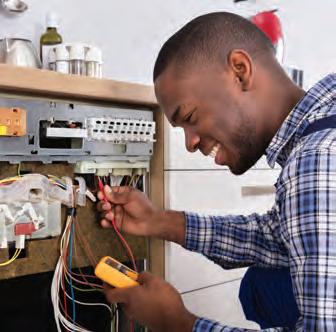
● Frequent problems with blowing fuses or tripping circuit breakers
● A tingling feeling when you touch an electrical appliance
● Discolored or warm wall outlets
● A burning or rubbery smell coming from an appliance
● Flickering or dimming lights
● Sparks from an outlet

Source: National Fire Protection Association
● Never run electrical cords across doorways or under carpets.
● Inspect cords for damage before use. Do not use if you find cracked or frayed sockets, loose or bare wires or loose connections.
● Buy extension cords that have the UL label on the packaging to make sure they meet the Underwriters Laboratories Standard.
● Don’t plug extension cords into one another.
● Keep outdoor extension cords clear of standing water.
● Make sure extension cords are rated for their intended use (indoor or outdoor) and meet or exceed the power needs of the device being used.
● Do not nail or staple extension cords to walls or baseboards.
● Do not run extension cords through walls, doorways, ceilings or floors.
● Keep children away from electrical cords and outlets.
Source: National Fire Protection Association
When the weather cools down, many Floridians turn to space heaters to stay warm. Space heaters may keep us warm, but they can be very dangerous if not used correctly.
Heating is the second leading cause of home fires and home fire injuries, and the third leading cause of home fire deaths.
From 2014-2018, local fire departments responded to an annual average of 48,530 fires involving heating equipment, causing:
● 500 civilian deaths
● 1,350 civilian injuries
● $1.1 billion in direct property damage
Source: National Fire Protection Association
DON’T place space heaters on cabinets, tables, furniture or carpet.

DON’T plug electric space heaters into an extension cord or power strip.
DON’T run a space heater’s cord under rugs or carpeting.
DON’T touch an electric space heater if you are wet.
DON’T leave space heaters on while they're unattended or while you are sleeping.
DO keep all sides of space heaters at least 3 feet away from anything that can burn.
DO place space heaters on a solid, flat surface where they will not be knocked over.
DO keep space heaters out of the way of foot traffic.
DO keep children and pets away from space heaters.
DO plug electric space heaters directly into a wall outlet.
DO keep electric space heaters away from water.
DO turn off and unplug space heaters when you leave the room or go to bed.
DO use the type of fuel specified by the manufacturer in fuel-burning space heaters.

In this class activity, you will inspect and evaluate the fire safety features of your school.
Create a poster-size chart with three columns. Title the columns: Fire prevention features, Fire extinguishing features and Evacuation features.
Divide the class into three groups. Each group will collect data on one way that their school building is designed to address fire safety:
1. Preventing a fire from occurring and/or spreading; 2. Extinguishing a fire; and
3. Evacuating people if a fire occurs.
First, use this publication to create an initial list of what data you will collect. Some additional safety features the groups will look for include: automatic sprinklers, emergency lighting, emergency exits and fire lanes.
As a class, brainstorm additional features for each group to collect data on. Some features may be in two categories. Arrange a non-disruptive time for each group to walk around the building and record fire safety data.
Once each group has gathered their information, compile the results on the chart. Compare the data and discuss similarities and differences between the columns. Based on your data, how safe do you think the building is in terms of:
1. Preventing the occurrence or spread of a fire?
2. Extinguishing a fire?
3. Evacuating people in the event of a fire?
DON’T refuel kerosene space heaters inside. Always refuel your cooled heater outside.
DON’T plug another electrical device or an extension cord into the same outlet as a heater.
DON’T use a space heater if the plug, cord, wall outlet or faceplate is hot.

DON’T use a space heater in a workshop or garage near paint, gas cans or matches.
Sources: Electrical Safety Foundation International, National Fire Protection Association, U.S. Consumer Product Safety Commission, U.S. Fire Administration
Finally, discuss how the building’s fire safety might be improved. Make a list of your recommendations. Compose a persuasive letter to your principal urging the school to consider making these changes. Use the letters to the editor in the Tampa Bay Times print or digital edition as examples.
Adapted from: NOVA, “Escape! Because Accidents Happen – Fire”
Florida Standards – Health: HE.612.B.5.2; HE.612.B.5.3; HE.612.B.5.5; HE.612.C.2.8; HE.612.P.7.1; HE.612.P.7.2; HE.612.P.8.1; HE.612.P.8.3; HE.612.P.8.4; HE.612.CE.2.1; HE.612.CE.2.2
Language Arts: ELA.612.C.1.2; ELA.612.C.1.4; ELA.612.C.1.5; ELA.612.C.3.1; ELA.612.C.4.1; ELA.612.R.2.1; ELA.612.R.3.2; ELA.612.V.1.1; ELA.612.V.1.3 Special Skills: SP.612.VI.9.11; SP.612. US.8.8 Science: SC.612.N.1.1
Fire and smoke are fast. Working smoke alarms give you early warning so you can get outside to safety quickly.
Roughly 3 out of 5 fire deaths happen in homes with no smoke alarms or no working smoke alarms.

Smoke alarms are inexpensive (a basic one starts at about $10) and simple to use.
When a smoke alarm sounds, get outside and stay outside. Call 9-1-1 from a cellphone or a neighbor’s phone.


● Inside each bedroom.
● Outside each sleeping area.
● On every level of the home.
● On the ceiling or high on the wall.
● At least 10 feet away from the stove.
● Large homes may need extra smoke alarms.
● When possible, install interconnected smoke alarms (when one smoke alarm sounds, they all sound).
● If any household members are deaf or hearing impaired, install smoke alarms with strobe lights and consider adding a pillow or bed shaker that activates when the smoke alarm goes off.
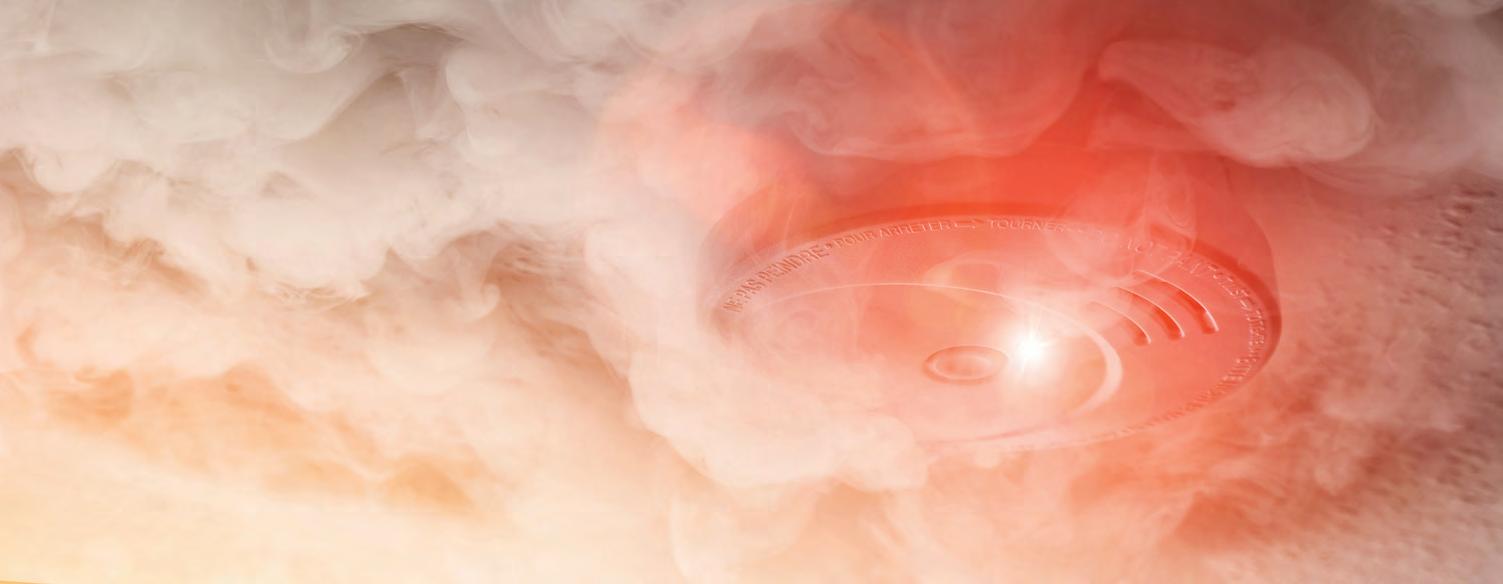
● Look for the UL label on the packaging to make sure the smoke alarm meets the Underwriters Laboratories Standard.
● When possible, choose smoke alarms that can be interconnected (when one smoke alarm sounds, they all sound).
● If anyone with hearing loss lives in your home, choose smoke alarms that flash a light in addition to sounding an audible alarm.
● Test your smoke alarms by pressing the test button at least once a month.
● Replace smoke alarm batteries once a year or when they make a “chirping” sound.
● Replace all smoke alarms every 10 years.
Sources: Consumer Reports, National Fire Protection Association, U.S. Consumer Product Safety Commission
When you change your clocks for Daylight Saving Time in the spring or fall, change your home’s smoke alarm batteries.
Knowing what to do in the event of a fire is particularly important for older adults.
At age 65, people are twice as likely to be killed or injured by fires compared to the population at large.
37 percent of Citrus County residents and 28 percent of Hernando County residents are 65 or older.
In 2018:
• Adults 65 and over had a 2.6 times greater risk of dying in a fire than the total population.
• Adults 85 and over had a 3.8 times greater risk of dying in a fire than the total population.
• Adults 85 and over had the highest rate of fire death and injury.
Sources: National Fire Protection Association, U.S. Census, U.S. Fire Administration
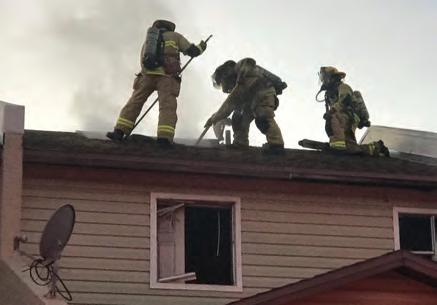
● If possible, consider sleeping in a room on the ground floor in order to make emergency escape easier.
● Know two ways out of every room, in case one exit is blocked or dangerous to use.
● Make sure that smoke alarms are installed in every bedroom and outside all sleeping areas.
● Make sure that you are able to open all doors and windows in your home.
● Have a landline telephone or cellphone and charger near your bed.
● Have other items needed to evacuate (such as glasses, wheelchair, scooter, walker or cane) near your bed.
● Keep a flashlight and whistle near your bed to signal for help.
● Consider subscribing to a medical alert system, which will provide a button to summon emergency responders.
● If anyone in the household is deaf or hearing impaired, install smoke alarms with strobe lights. Consider adding an alert device such as a pillow or bed shaker that activates when the smoke alarm goes off.

Source: National Fire Protection Association
Individually, have each student make a list of how many smoke detectors are installed in each room, area and level of his or her home.
As a class, create a bar graph showing how many families have one, two, three, four, or five or more smoke detectors. Discuss where each smoke detector is located in the home and why the family chose to put a smoke detector there. Discuss where additional smoke detectors might be installed to improve the home’s fire safety. Look at the classified ads for homes and real estate rentals in the Bay Link section of the Tampa Bay Times. Illustrate one of the homes based on the description in the newspaper. Make a note of all of the rooms where there should be smoke detectors. Share this illustration and information with your class.
Adapted from: Education World, “Fire Safety: Activities to Spark Learning!”
Florida Standards – Health: HE.612.C.1.2; HE.612.C.1.8; HE.612.C.5.1; HE.612.B.6.2; HE.612.P.7.1 Language Arts: ELA.612.C.1.2; ELA.612.C.1.4; ELA.612.C.1.5; ELA.612.C.3.1; ELA.612.C.4.1; ELA.612.R.2.1; ELA.612.R.3.2; ELA.612.V.1.1; ELA.612.V.1.3
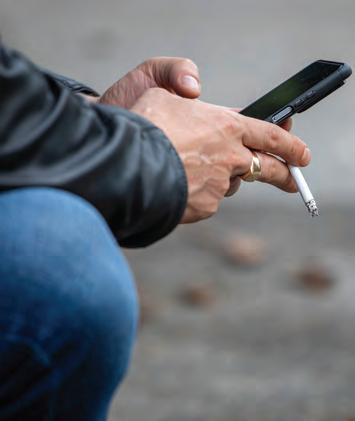
Each year, smoking causes an average of:

Source: National Fire Protection Association, Home Fires Started by Smoking
● Smoke outside. Most deaths result from fires that started in living rooms, family rooms or bedrooms.
● Never smoke in bed. Mattresses and bedding can catch on fire easily. Do not smoke in bed because you might fall asleep with a lit cigarette.
● Keep smoking materials out of the reach of children up high in a locked cabinet.
● Use a deep, sturdy ashtray or bucket with sand. Place it away from anything that can burn.
● Put cigarettes out all the way. Don’t walk away from lit cigarettes and other smoking materials. Put water on ashes and butts to make sure they are really out before you put them in the trash.
● Be alert. Do not smoke after taking medicine that makes you tired. You may not be able to prevent or escape from a fire if you are sleepy.
● Never smoke around medical oxygen.
● Do not discard cigarettes in mulch, leaves or other things that could ignite easily.
Sources: National Fire Protection Association, U.S. Fire Administration
Smoking is the leading cause of burns, fires, deaths and injuries involving home medical oxygen.
Oxygen itself does not burn, but a fire needs oxygen to start and to keep burning. When more oxygen is in the air, a fire will burn hotter and faster.
If oxygen is used in the home, the amount of oxygen in the air, furniture,

clothing, hair and bedding goes up, making it easier for a fire to start and spread. This means that there is a higher risk of both fires and burns.
● Never smoke or vape in a home where medical oxygen is used.
● Post “no smoking” signs inside and outside of the home to remind residents and guests not to smoke.
● Never use an open flame, such as lighters, matches, candles, wood stoves or gas ranges, when medical oxygen is in use.
Sources: National Fire Protection Association, U.S. Fire Administration
● Fires or explosions caused by the lithiumion batteries used in e-cigarettes are not common, but the consequences can be devastating and lifealtering for the victims.
● Between 2009 and 2016, there were 195 explosions and fires involving e-cigarettes, resulting in 133 acute injuries.
● Fires have occurred while e-cigarettes were being used, while in a pocket and while the battery was being charged.
The fire triangle is a simple way of understanding the elements of fire. The sides of the triangle represent the three ingredients needed for fire: heat, fuel and oxygen.
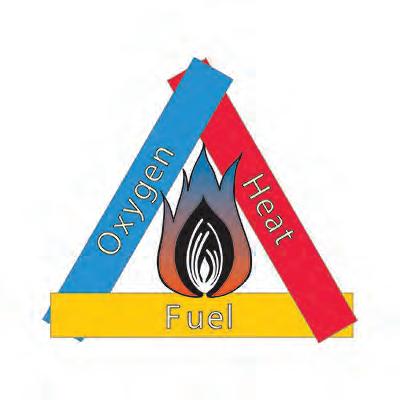
DO charge your e-cigarette on a clean, flat surface, away from anything that can easily catch fire.
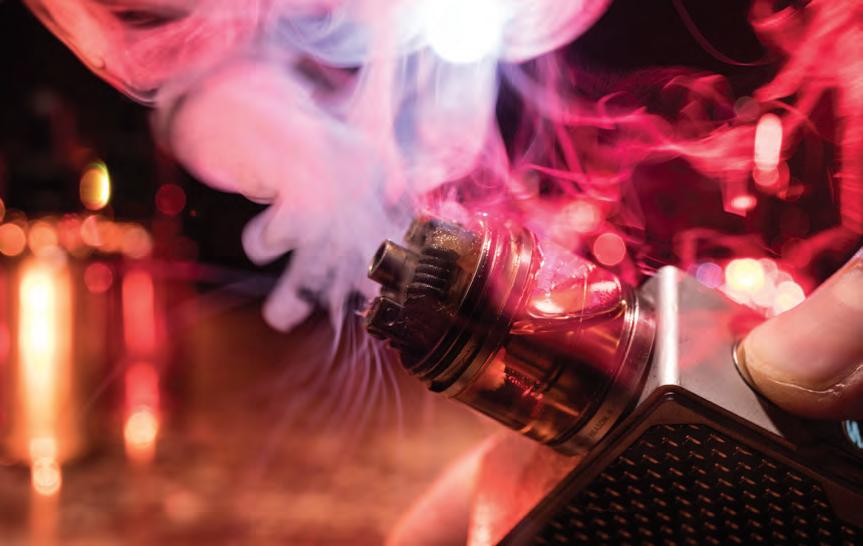
DO store extra batteries for your e-cigarette in a case. Keep them away from metal objects such as keys or spare change.
DO protect your e-cigarette and extra batteries from extreme temperatures.
DO replace the batteries if they get wet or damaged.
DON’T charge your e-cigarette with a phone or tablet charger. Always use the charger that came with it.

DON’T charge your e-cigarette overnight or leave it charging unattended.
DON’T mix different brands of batteries, use batteries with different charge levels or use old and new batteries together.
Sources: National Fire Protection Association, U.S. Fire Administration, U.S. Food and Drug Administration
HEAT: A heat source is needed for the initial ignition of a fire. Once a fire has started, it produces the heat needed to continue burning. Examples of heat sources include stoves, candles and smoking materials.
FUEL: Fuel is any kind of combustible material. Examples of fuel include oil and grease, paper, plastic, propane, cloth and leaves.
OXYGEN: Air contains about 21 percent oxygen. Most fires require at least 16 percent oxygen content to burn.
For a fire to occur, you must have all three ingredients of heat, fuel and oxygen. If any one of these elements is missing, a fire will not start. When one of these components is removed from a fire, it stops burning. For example, when you place a lid over a grease fire, you cut off the oxygen. When all the wax (fuel) is gone from a candle, it goes out. And when you put water on a cigarette butt, you cut off oxygen and remove heat.
Look through the Tampa Bay Times for images – cartoons, photos, ads and graphics – that represent the elements of heat, fuel and oxygen. Find at least five of each. Cut out the images and create five illustrated fire triangles. Share your creations with your class. If possible, post the fire triangles in your classroom or school hallway or cafeteria.
Florida Standards – Health: HE.612.C.1.2; HE.612.C.1.8; HE.612.C.5.1; HE.612.B.6.2; HE.612.P.7.1 Language Arts: ELA.612.C.2.1; ELA.612.R.2.1; ELA.10.R.3.2; ELA.612.V.1.3 Science: SC.612.N.1.1; SC.612.E.7.7; SC.612.P.11.1
Service area: City of Crystal RiverService area: Unincorporated Citrus County
● 10 fire stations
12 engines
1 technical rescue engine
13 ambulances
1 ladder truck
10 brush trucks
5 tankers
marine units
2 ATV units
Hazardous Materials (HazMat)
Urban Search and Rescue
184 full-time employees
92 career firefighters
83 paramedics and EMTs
● 12 part-time instructors
CONTACT INFORMATION:
Phone (non-emergency): 352-527-5406
Email: fireinfo@citruscountyfire.com
Website: citruscountyfire.com
Facebook: facebook.com/ citruscountyfirerescue
Twitter: twitter.com/citruscofire
Citrus County Fire Rescue (CCFR) serves unincorporated Citrus County with automatic and mutual aid agreements in place with the cities of Inverness and Crystal River. Their service area encompasses 773 square miles, of which 189 square miles is water.
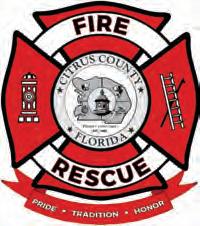
CCFR provides community risk reduction programs including fire and life safety education, business inspections, fire investigations, smoke detector installation, checks and battery replacement, station tours, a fire safety house at schools and special events and public education at community events.
To request the Fire Safety House or other CCFR presence at your special event, visit citrusbocc.com/ departments/fire_rescue/special events_request.php.
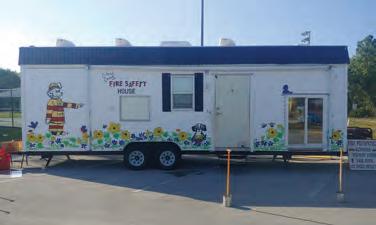
● 1 fire station
● 3 engines
● 1 brush truck
● 1 squad unit
● 1 marine unit
● 20 volunteer firefighters/ support personnel
CONTACT INFORMATION:
Phone (non-emergency): 352-795-4216, ext. 401 Website: crystalriverfl.org/fire
The Crystal River Fire Department (CRFD) serves the City of Crystal River and, through a mutual aid agreement with Citrus County Fire Rescue, may provide services in unincorporated areas of Citrus County.

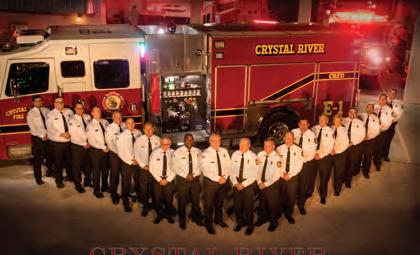


The department protects the lives and property of citizens, business owners and visitors by providing fire and life safety prevention, public education,
emergency medical services, fire suppression and search and rescue operations.
Understanding that education is the key to prevention, the department offers fire safety presentations and equipment demonstrations to the public.
Are you interested in volunteering and serving your community as a first responder? CRFD is accepting applications for new members. Approved new members will receive free training and equipment. For more information, contact CRFD at 352-795-4216, ext. 401 or visit the station at 123 NW U.S. 19.
In this activity, you will plan, conduct and document an interview with an individual who works in the fire services. You can research fire service careers using the Bureau of Labor Statistics Occupational Outlook Handbook at bls. gov/ooh.
First, get the permission of and arrange a time to meet with the person you want to interview. Plan a visit, phone call or online meeting that takes no longer than about an hour.
Next, conduct some background research on your topic and interviewee. Before the interview, develop a list of 7-10 questions. Asking the right kinds of questions will result in more meaningful responses. Keep questions short, and ask open-ended, not yes/no, questions. Write down new questions as you think of them during the interview. Some example questions might include:
● When were you born?
● Where were you born?
● Where did you grow up?
● What brought you to Florida? (if they did not grow up in Florida)
● How long have you been involved with the fire services?
● What got you interested in it?
Phone (non-emergency): 352-726-2611 ext. 1701

Email: bbessler@Inverness.Gov Website: inverness-fl.gov/453/ Fire-Department Facebook: facebook.com/ InvernessFireDept
The Inverness Fire Department (IFD) offers free fire prevention and education programs to City of Inverness residents and businesses, including presentations, station tours, equipment demonstrations and fire and lifesafety programs.

Do you want to become a firefighter/EMT? IFD will start you on your career path for free! Department volunteers receive free training, and no experience is necessary. Contact the department for more information or fill out a volunteer application, available at the Inverness Fire Department, 105 S Apopka Ave., or the Inverness Government Center, 212 W Main St.
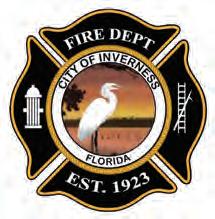
● How did you learn it?
● Why is working in this field important to you?
● What advice would you like to give young people interested in a career in the fire services?
Finally, decide how you want to document the interview (handwritten notes, photographs, and/or audio/video recording). If you plan to take photographs, think about the different things you may want to take pictures of. For example, you may want to take a portrait of the person, some pictures of the person at work or some photos of the equipment they use. Be sure to ask for permission before recording or taking photographs.
After the interview, write everything down you can remember about the person you interviewed and what was happening around you. At home, expand your notes by following up on things you learned in your interview with more research. Write up your interview as though it was going to appear in the Tampa Bay Times.
Sources: New Hampshire State Council on the Arts, ReadWriteThink, The Washington Post Newspaper In Education Program, “Interviewing 101”
Florida Standards – Language Arts: ELA.612.C.1.2; ELA.612.C.1.4; ELA.612.C.1.5; ELA.612.C.3.1; ELA.612.C.4.1; ELA.612.R.2.1; ELA.612.R.3.2; ELA.612.V.1.1; ELA.612.V.1.3 Science: SC.612.CS-CC.1.1 SC.612CS-CC.1.2
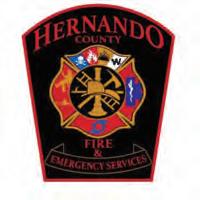
Service area: Hernando County
● 14 fire stations
● 13 engines
● 1 ladder truck
● 3 water tender supply trucks
● 8 wildland brush fire trucks
● 3 Battalion Chief vehicles
● 12 advanced life support ambulances
● 292 full-time firefighters/ paramedics/EMTs/other
CONTACT INFORMATION: Phone (non-emergency): 352-540-4353
Email: HCFRInfo@hernandocounty.us
Website: hernandocounty.us/ departments/departments-f-m/ fire-rescue-1652
Hernando County Fire & Emergency Services (HCFES) is responsible for the safety and welfare of nearly 200,000 residents and the visitors of Hernando County. Their geographic boundaries encompass just over 472
square miles. This includes providing emergency medical services to the City of Brooksville (Brooksville Fire Department provides fire services within the geographic boundaries of the city).

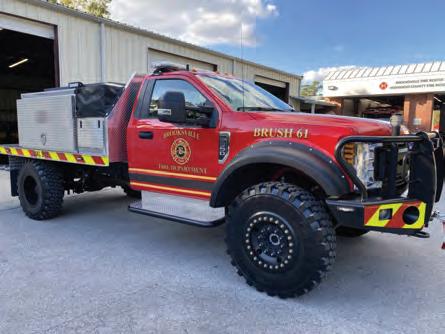

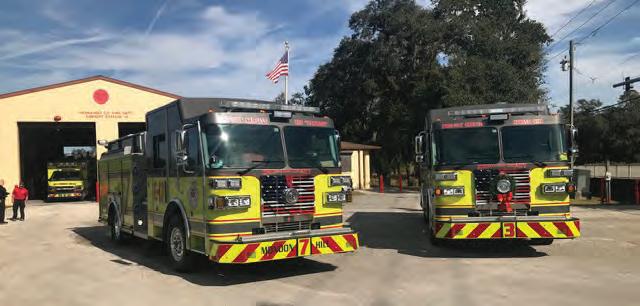
HCFES’ fire prevention division and volunteer fire corps section provide public education programs including fire safety presentations to local schools, businesses and community groups throughout the year.
HCFES provides fire suppression, emergency medical services, technical rescue, hazardous materials response and mitigation, aircraft rescue and firefighting services, water-based rescue, fire prevention, emergency management services and many other forms of assistance to Hernando County. HCFES responds to more than 37,000 calls for service annually.
Service area: City of Brooksville (ZIP code 34601)
● 1 fire station
● 2 engines
● 1 tower
● 1 brush truck
● 20 full-time firefighters/ paramedics/EMTs
CONTACT INFORMATION: Phone (non-emergency): 352-540-3840
Website: cityofbrooksville.us/208/ Fire-Department

The Brooksville Fire Department (BFD) offers free fire prevention and education programs, including presentations, station tours, equipment demonstrations and fire and life-safety programs to all City of Brooksville residents, community groups, schools and businesses. The department also offers a Free Smoke Alarm Program to Brooksville/Hernando residents, a program funded in part by a FEMA Assistance to Firefighters Grant. To learn more about BFD programs, visit cityofbrooksville. us/217/PublicEducation.
The first reported fire in Brooksville gutted the courthouse and its records on Sept. 28, 1877. Prior to 1912, when the Brooksville Fire Department was founded, residents alerted by the city’s fire alarm – an old circular saw and a large mallet hanging from a post on the courthouse square – would form a bucket brigade to fight fires.
Crystal River Fire Department was founded in 1915, and the first station to house a fire truck was in the Old City Hall, built in 1939 (now the Coastal Heritage Museum).

Crystal River’s first dedicated fire station was constructed in 1960 for less than $1,000. According to the Tampa Tribune, “Members of the (Crystal River) Fire Department had a material problem and they found the solution in the woods. They made a deal with a local sawmill. For every log the sawmill cut into boards (for the fire department), the mill got one log free.”
In 1976, they did it again. Local merchants and contractors supplied materials and labor at reduced costs, and the 12 fire department members worked evenings and weekends to build the station. The new station, pictured above, was dedicated on May 15, 1976.
Source: The Tampa Tribune
In 1925, the city purchased a new LaFrance engine for $12,500, which could pump 450 gallons a minute. A second fire engine, pictured below, was obtained in 1952 and was still in service in 1979 as a tanker.

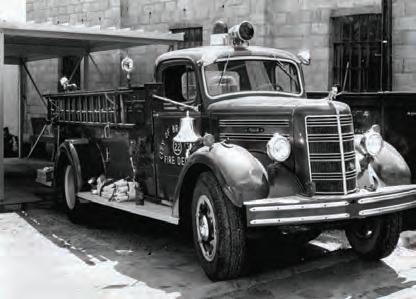
Source: Tampa Bay Times
When you think about careers in the fire service, you probably think of firefighters. However, while line firefighters have very important jobs, there are many other important roles in the fire service. For example, if you would like:
• A career that requires bravery, physical skill and calm under pressure, think about being a line firefighter.
• A medical career, think about becoming a paramedic or Emergency Medical Technician.
• A career in architecture or engineering, think about being a plans reviewer.
• A career that requires good communication skills and a calm
demeanor, think about being a dispatcher.
• A job using new technology, think about becoming a fire department GIS coordinator.
• A job that uses science and math to keep people safe, think about the fire protection engineer field.
• A career that examines patterns in data and research, think about becoming a fire department data scientist.
• A career working with business owners to make sure their properties are safe for people, think about being a fire marshal.
• A career where you get to rescue people in the water, thinking about joining a search and rescue dive team.
Research fire service careers using the Bureau of Labor Statistics Occupational Outlook Handbook at bls.gov/ooh. Select one or more occupations that seem interesting to you and answer the following questions:
• How does the occupation fit your skills and interests?
• What will you be doing in the occupation?
• What is the necessary education and/ or training?

• How many jobs are there in the occupation currently?
• Is the occupation projected to grow, decline or remain unchanged? Why?
• How much does this occupation pay? What do the top 10 percent earn? The bottom 10 percent?
The Inverness Fire Department’s first-ever ladder-tower truck rolled into Inverness Wednesday, April 20, 1983, after a three-day, 1,300-mile drive by then-Inverness Fire Chief Randy Messer and Wichita (Kan.) Fire Chief Jim Martin. Messer said the drive from Wichita wasn’t as bad as you might think. The truck handled well on the highways.

Using the articles in the Tampa Bay Times as models, prepare a news article using the information collected above to help others assess whether they would pursue a career in the selected occupation and why or why not. Present your findings to your class.
Adapted from: National Fire Protection Association, “Lesson Plan: Careers in the Fire Service” and U.S. Bureau of Labor Statistics, “Choosing a career: activity”
Florida Standards – Language Arts: ELA.612.C.1.2; ELA.612.C.1.4; ELA.612.C.1.5; ELA.612.C.3.1; ELA.612.C.4.1; ELA.612.R.2.1; ELA.612.R.3.2; ELA.612.V.1.1; ELA.612.V.1.3
tampabay.com/nie 15 Source: Tampa Bay Times

This publication was funded by a grant from FM Global’s Fire Prevention Grant Program.
Established nearly 200 years ago, FM Global is a mutual insurance company whose capital, scientific research capability and engineering expertise are solely dedicated to property risk management and the resilience of its client-owners. These owners, who share the belief that the majority of property loss is preventable, represent many of the world’s largest organizations, including one of every three Fortune 500 companies. They work with FM Global to better understand the hazards that can impact their business continuity in order to make cost-effective risk management decisions, combining property loss prevention with insurance protection.
Through its Fire Prevention Grant Program, FM Global awards grants to fire departments, as well as national, state, regional, local and community organizations worldwide, that best demonstrate a need for funding, where dollars can have the most demonstrable impact on preventing fire, or mitigating the damage it can quickly cause.
To learn more about FM Global’s Fire Prevention Grant Program and other resources for the fire service, visit fmglobal.com/fireservice.
The Tampa Bay Times Newspaper in Education program (NIE) serves educators, students and families by providing K-12 schools with class sets of the Pulitzer Prize-winning Tampa Bay Times – a “living textbook” – plus award-winning original curriculum supplements, teacher guides, lesson plans, teacher professional development resources and much more – all at no cost to schools, teachers or families.

In 2021-2022, NIE provided more than 10.5 million digital licenses and almost half a million print copies of the Times to area classrooms free of charge thanks to our generous subscribers and individual, corporate and foundation sponsors.

NIE is a member of Florida Press Educational Services, a 501(c)(3) nonprofit organization whose mission is to promote reading and critical thinking, particularly for young people.
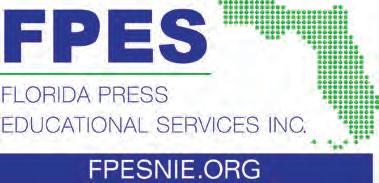
For more information about NIE, visit tampabay.com/ nie, call 727-893-8138 or email ordernie@tampabay.com. Follow us on Twitter at twitter.com/TBTimesNIE. Find us on Facebook at facebook.com/TBTNIE.

After reading this publication, complete a short survey about your knowledge of fire safety to be entered into a drawing to win a smoke alarm! Visit surveymonkey. com/r/ZX6B5LP for details and to enter. Entry deadline is Dec. 31, 2022.
Jodi Pushkin, manager, jpushkin@tampabay.com
Sue Bedry, development officer, sbedry@tampabay.com
© Tampa Bay Times 2022
Written by: Sue Bedry, Times staff
Curriculum activities by: Sue Bedry and Jodi Pushkin, Times staff
Designed by: Stacy Rector, Fluid Graphic Design
This publication and the activities focus on the following Florida Standards.
Florida Standards – Health: HE.612.B.3.3; HE.612.B.4.3; HE.612.B.5.1; HE.612.B.5.3; HE.612.B.5.5; HE.612.C.1.2; HE.612.C.1.8; HE.612.C.1.3; HE.612.C.5.1; HE.612.B.6.2; HE.612.P.7.1; HE.612.P.7.2 Language Arts: ELA.612.C.1.2; ELA.612.C.1.4; ELA.612.C.1.5; ELA.612.C.3.1; ELA.612.C.4.1; ELA.612.R.2.1; ELA.612.R.3.2; ELA.612.V.1.1; ELA.612.V.1.3 Science: SC.612.N.1.1; SC.612.N.1.5; SC.612.CS-CC.1.1 SC.612CS-CC.1.2; SC.612.E.7.7; SC.612.P.11.1 Special Skills: SP.612.VI.9.11; SP.612.DH.6.3; SP.612.US.8.9
Share 100 words about how you used this resource in your classroom for a chance to win a $15 gift card!
Visit tampabay.com/nie for details and to enter.